
The Complete Guide to Reducing Cart Abandonment
Have you ever spent your entire afternoon shopping online, only to change your mind moments before finalizing your purchase? If so, you’re one of the many online customers who’ve abandoned an order at the last minute—a process known as cart abandonment.
An undeniable problem within the online retail industry, cart abandonment causes businesses to lose out on potential earnings for various reasons. Sometimes, it’s simply because the customer experienced some preemptive buyer’s remorse.
The good news is that many of those reasons can be avoided, and with a little preparation, you can stop cart abandoners from eating into your profits.
What Cart Abandonment Is & Why it Matters
Cart abandonment occurs when customers add items into their virtual shopping cart and then, for whatever reason, leave the website without completing their purchase. It’s part of a wider range of “abandonment” terms used in ecommerce, which include:
- Booking Abandonment: When a customer starts booking accommodation or a flight and then backs out at the last minute.
- Browse Abandonment: Similar to cart abandonment, except in this case the potential customer doesn’t add any items to their virtual cart. They simply browse the site and then leave.
- Form Abandonment: When a prospective customer fails to finalize a quote, subscription, or product purchase because they’re required to complete a long form.
Each type of abandonment issue contributes to lost earnings, which is why it’s important to identify and correct them as soon as possible. Otherwise, your company risks losing out on a significant amount of revenue.
Why Cart Abandonment Matters
If your store has a high cart abandonment rate, it means your customers started their purchasing journey but had second thoughts somewhere along the way.
It’s possible that the customer’s decision to abandon their purchase was influenced by factors outside your control—perhaps they were conducting price research or decided they wanted to buy the product in-person instead—or your cart abandonment rates could be equally influenced by your store policies.
“Fifty-nine percent of shoppers will abandon their shopping cart if they don’t see a checkout page that’s in their local currency, payment type and language,” Ralph Dangelmaier, CEO of BlueSnap.
In addition, cart abandonment rates vary depending on the industry. Finance, travel, and nonprofit routinely have the highest cart abandonment rates, while gaming and fashion are consistently below the global average.
Even within the same industry, cart abandonment rates can vary depending on the sub-industry.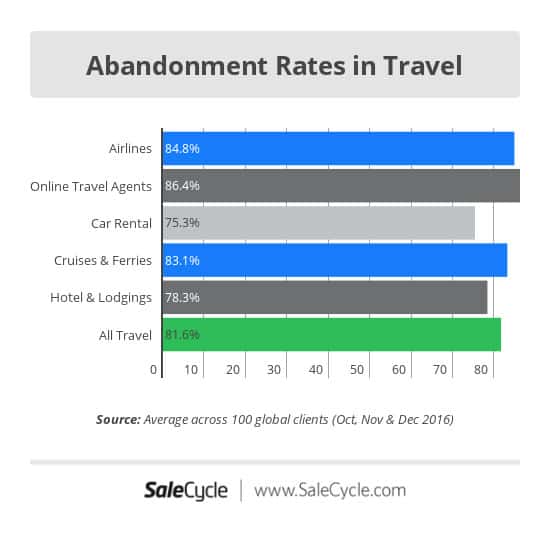 (Source: SaleCycle average across 100 global clients for Oct, Nov & Dec 2016)
(Source: SaleCycle average across 100 global clients for Oct, Nov & Dec 2016)
We’ll dig deeper into industry averages in a bit. For now, the important thing to remember is that your cart abandonment rates can be reduced by locating any contributing factors and working to correct them. Even a minor reduction in abandonment rates can significantly increase your profit margin.
Let’s say your website attracts 250,000 visitors every month, you have an average order value of $180, and you’ve got a visitor-to-sale conversion rate of 0.42%. Right now, your company is bringing in $189,000 every month. But if you could increase your conversion rate by as little as 0.03%, your monthly revenue would increase by $13,500.
That’s an annual increase of $162,000, all because you were able to slightly reduce your cart abandonment rates.
Current Ecommerce Cart Abandonment Averages
So, now that we’ve covered the basics of cart abandonment, how much of ecommerce is really affected by this problem? Well, research indicates that cart abandonment rates are on the rise.
According to a study conducted by Barilliance, the average global abandonment rate rose from 77.24% in 2016 to 78.65% the following year. With more than 75% of online shoppers abandoning online purchases, it’s easy to see exactly how much cart abandonment can put a damper on your company’s earning potential.
Similarly, Statista analyzed third-party data and found that the global cart abandonment average grew by nearly 16% over an 11-year period.
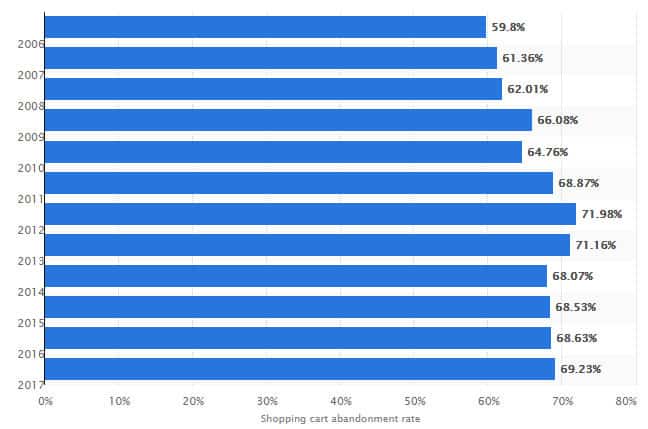
(Source: Statista)
What’s even more interesting is how cart abandonment rates are influenced by the type of device the shopper uses.
In 2015, Barilliance looked at abandonment rates across devices and discovered that mobile users abandoned carts at a significantly higher rate than desktop users. Here are the rates for each device:
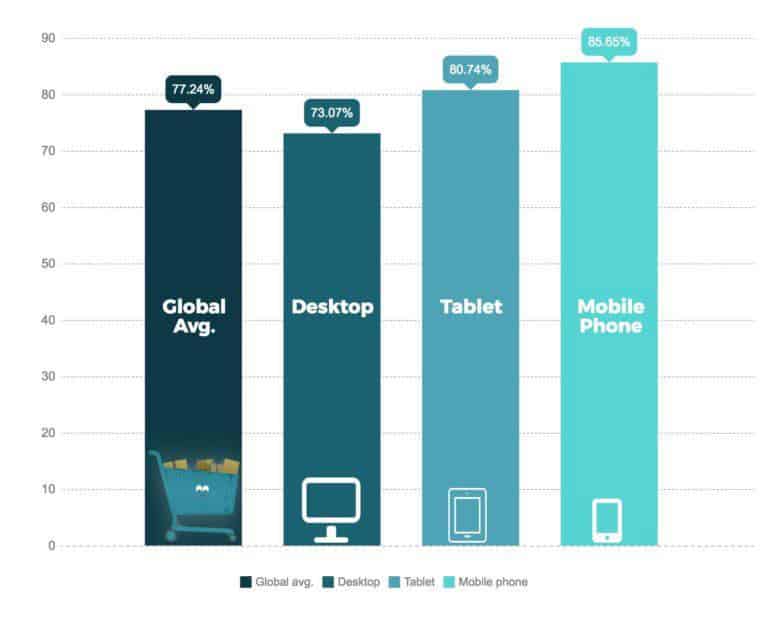
(Source: Barilliance)
But why would mobile devices account for the majority of cart abandonment rates when more than half of all ecommerce traffic comes from smartphones and tablets?
According to a study conducted by Addressey (now known as Loqate) in 2017, most mobile users abandoned their carts when their shopping experience felt inconvenient.
- 39% of mobile users abandoned their carts after they had issues entering their personal information
- 35% abandoned their cart because their screen felt cramped or too small
- 27% abandoned their cart due to problems entering their order correctly
These findings suggest that a significant portion of the mobile abandonment rate have to do with unresponsive website designs. With that said, switching your website over to a mobile-responsive design is relatively easy to do—and it can improve your SEO ranking.
Also, you want to keep your checkout process short and sweet. The inconvenience of lengthy, form-heavy checkouts is exacerbated on mobile devices, which could be contributing to your abandonment rate.
How Abandonment Rates Vary by Industry
As we mentioned earlier, cart abandonment rates vary depending on the industry. While abandonment happens to every type of business in ecommerce, some industries are affected by it more than others.
In the first quarter of 2018, the average cart abandonment rate was 75.6%, while the travel and finance industries experienced abandonment rates above the global average.
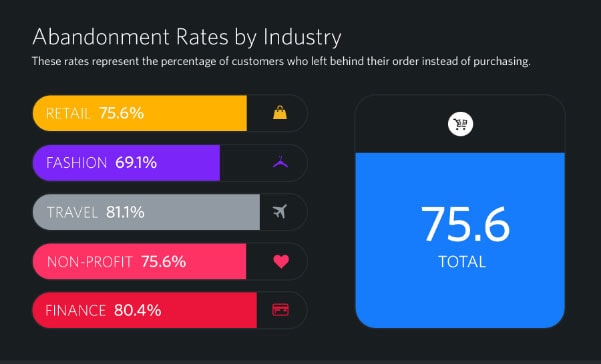
(Source: SaleCycle’s Q1 2018 Marketing Report)
It’s also important to note that the non-profit sector, which has historically struggled with above-average cart abandonment rates, dropped from 79.2% in fourth-quarter 2017 and now equals the global average of 75.6%.
While there are various contributing factors that influence cart abandonment rates, some of these industry-specific abandonment rates have to do with the nature of the purchasing journey in that industry. Fashion has below-average abandonment rates largely because buying clothes is a quick and straightforward process, whereas finance purchases are often accompanied by lengthy applications that customers may find overwhelming or frustrating.
Interestingly enough, research and price comparison seem to be two of the main reasons why the travel industry has high abandonment rates.
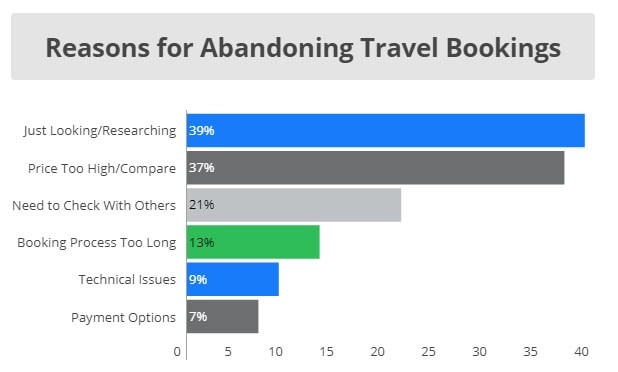
(Source: SalesCycle)
Leading Causes of Ecommerce Cart Abandonment
First and foremost, it’s important to understand that cart abandonment is, to some degree, an unavoidable occurrence. There are many reasons why a potential customer decides to abandon a purchase that has nothing to do with your product, services, or website design.
With that said, understanding some of the underlying factors that contribute to cart abandonment is critical to helping you understand how to curb abandonment rates and increase your revenue.
So, why do most consumers cancel their purchases? For various reasons, it seems.
In 2015, digital buyers in the United States were asked to give reasons why they had abandoned purchases. We learned that the top three causes of cart abandonment in the United States are due to:
- Unexpected Shipping Costs: 25%
- Having to Create a New Account to Finalize an Order: 22%
- Customers Researching & Comparing Prices with No Intention of Buying: 17%
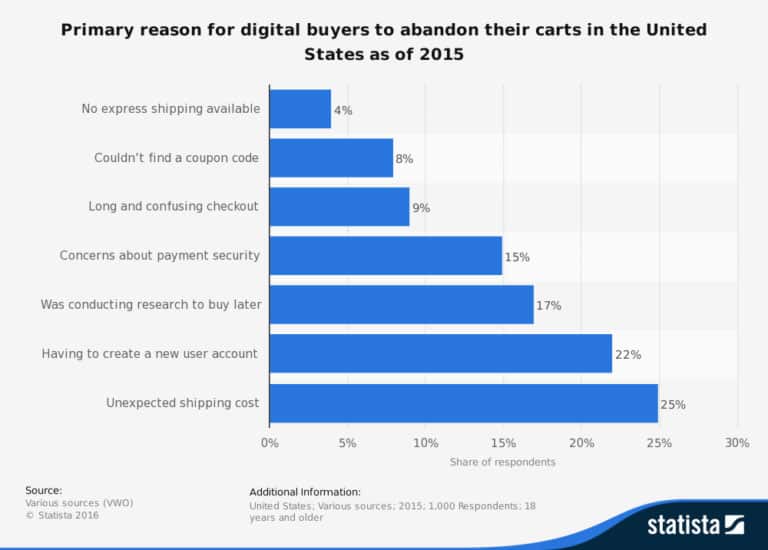
(Source: Statista)
Surveys conducted in 2016 and 2017 both had similar results, which leads us to believe that there are two common reasons why customers abandon purchases:
- They never had the intention of buying a product
- They became frustrated with the customer service and purchasing process
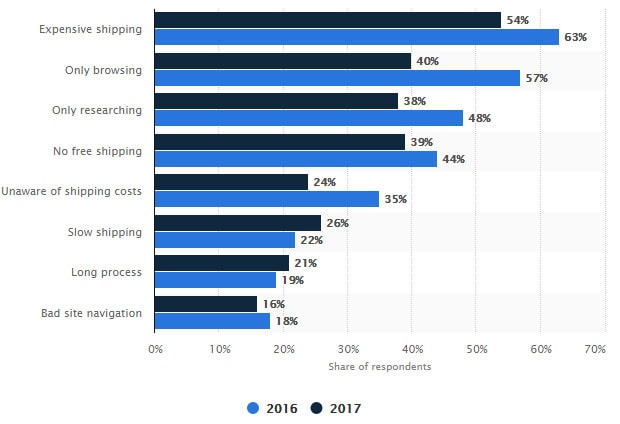
Top reasons for cart abandonment in the United States in 2016 and 2017 (Source: Statista)
To get a better idea of how brands can reduce cart abandonment, let’s look at this study conducted by the Baymard Institute on checkout abandonment.
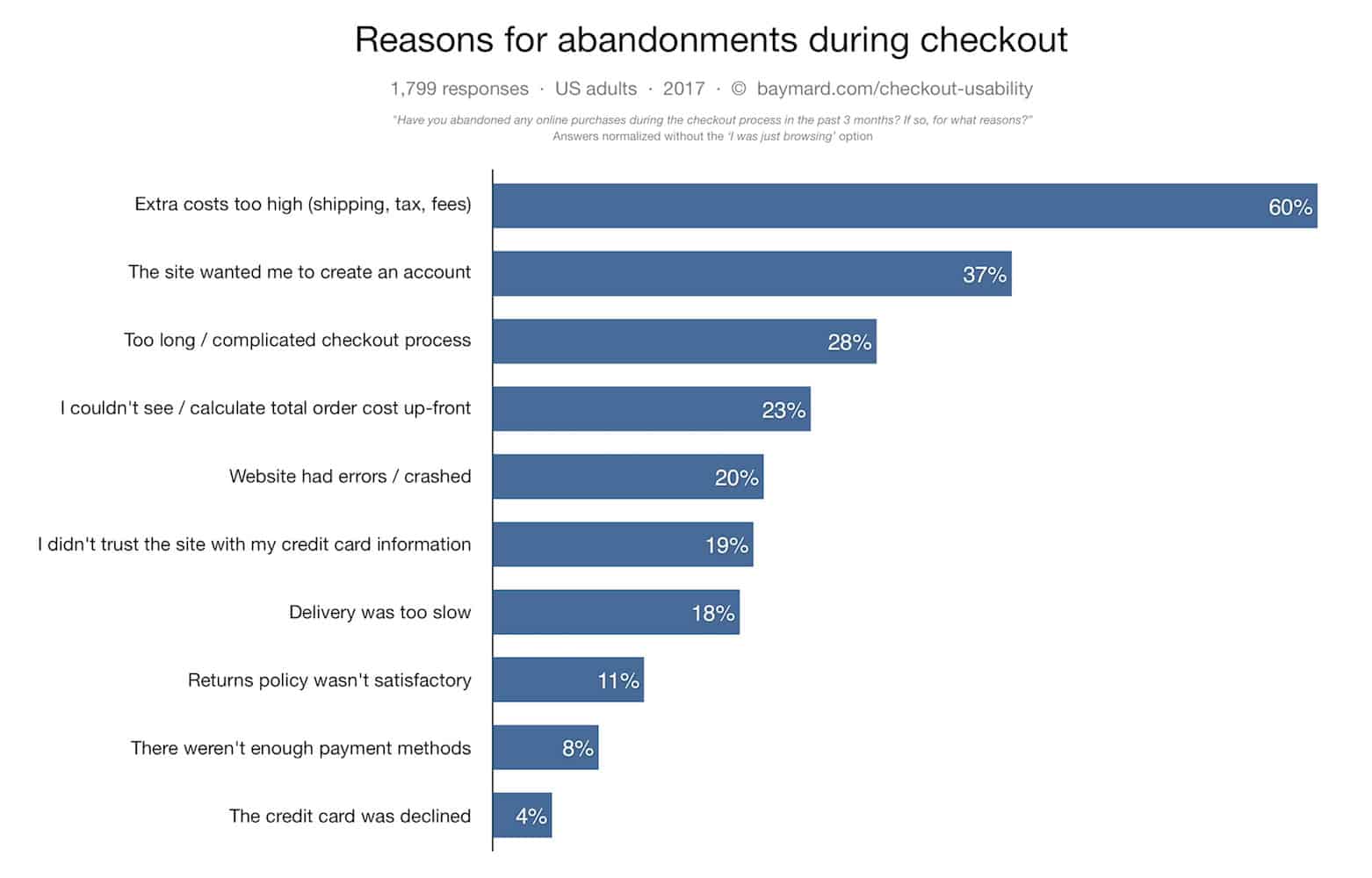
(Source: Baymard Institute)
This study is helpful due to the fact that it doesn’t look at shopping cart abandonment caused by customers researching or browsing merchandise. Instead, it gives us a breakdown of correctable issues that contribute to lost sales.
This data tells us that customers value a convenient and efficient shopping experience. While money remains the main motivator for cart abandonment, things like multiple payment options, speedy delivery times, up-front costs, and a hassle-free purchasing process are all elements that customers look for in an ecommerce company.
Email Basics & Best Practices
Now that we looked at what cart abandonment is and covered some of the factors that can cause it, let’s see how you can combat abandoned carts and recoup some of your potential earnings. And to do that, you need to come up with a solid strategy for sending cart abandonment emails.
But how effective are abandonment emails? Pretty successful when you consider the following statistics:
- Abandonment emails have a success rate of nearly 30%
- On average, the first email in a multi-email sequence has an open rate of 54% and a click-through rate of 28%
- Fashion company, Lucky Brand Jeans, benefitted from a 300% increase in cart recovery sales thanks to their abandonment email campaign
Building an Effective Emailing Strategy
When it comes to sending abandonment emails, timing is everything. If you contact potential customers too soon, they may view you as too pushy and demanding. But if you wait too long, your chances of converting start to diminish.
We recommend sending your first email an hour after the cart has been abandoned, followed by a follow-up email 24 hours later and a final email delivered three days after your first email.
The reason why it’s important to wait an hour before sending your first email is because that’s when you have the best chance of converting, as demonstrated by the following graphic.

(Source: SaleCycle Client Data from Q1 2018)
For best results, your abandonment emails should be sent in three stages:
- The first email should be about engaging with the customer. Start a conversation with them, let them know they didn’t complete their purchase, and remind them of what items they left in their cart.
- The second email should encourage the reader to finalize their purchase. Make sure to have a helpful tone. Tell the customer that you noticed they left their items in the cart, and ask if there were any problems that you can assist them with.
- The final email should entice the reader to complete their purchase by offering a discount. Send them an image with a coupon code, and tell them if they come back and complete the checkout process, they’ll receive a discount.
It’s important that you don’t offer a discount in your first email. Otherwise, you eliminate the chance of maximizing your earning potential from customers who would’ve completed their purchase in the first or second phase of your emailing campaign.
When composing your emails, you want to come up with a clever, attention-grabbing title the customer will read. For a good example of this, have a look at Smileycookie.com’s abandonment email campaign. They wanted to set the tone as helpful and supportive in their first email, so they went with a subject line that offered to assist the customer with finalizing their order:
“Oops…Was there a problem checking out?”
For their subsequent emails, they put the discount in their subject line alongside a quick call-to-action encouraging the reader to complete their purchase.
Tactics for Reducing Cart Abandonment with Email
Did you know that 75% of customers who abandon their purchase intend to complete their purchase at a later time?
Of that number, less than 10% of cart abandoners actually do complete their purpose. That leaves a large portion of potential customers who can be retargeted and engaged through your cart abandonment campaign.
Let’s look at six simple steps that can help you reduce cart abandonment rates and maximize your company’s earning potential.
Leverage the Power of Social Proof
Social proof is one of the most powerful tools you have at your disposal. By simply including elements like customer reviews, testimonials, and quantifiable data (“1,000 other customers enjoyed this product!”), you’re effectively using the power of popularity to persuade potential customers to buy your product—a phenomenon psychologists refer to as the bandwagon effect.
Incorporating elements of social proof into your abandonment emails is a great way to sway potential customers, increasing the likelihood of a shopper who was “on the fence” to complete their purchasing journey.
Here’s how you can do it:
- Choose the Right Product: Review the list of products in the customer’s abandoned cart and choose the one product they’re most likely to purchase. This will be the product you include in your abandonment email.
- Sell It: Talk about the benefits of owning the product, as well as what your customers are missing out on by not purchasing it.
- Bring in the Social Proof: Including a simple rating or product review in your email can go a long way towards maximizing your abandoned cart recovery. Not only do these elements draw more attention to the product, but it also tells the reader how the product has helped similar customers.
Keep in mind that many customers who abandoned their carts still plan on buying the products, just not at this particular moment. Social proof in the form of testimonials and ratings are great for reminding those customers why they initially wanted the product, while also incorporating other shoppers’ experiences to illustrate the value that the product brings.
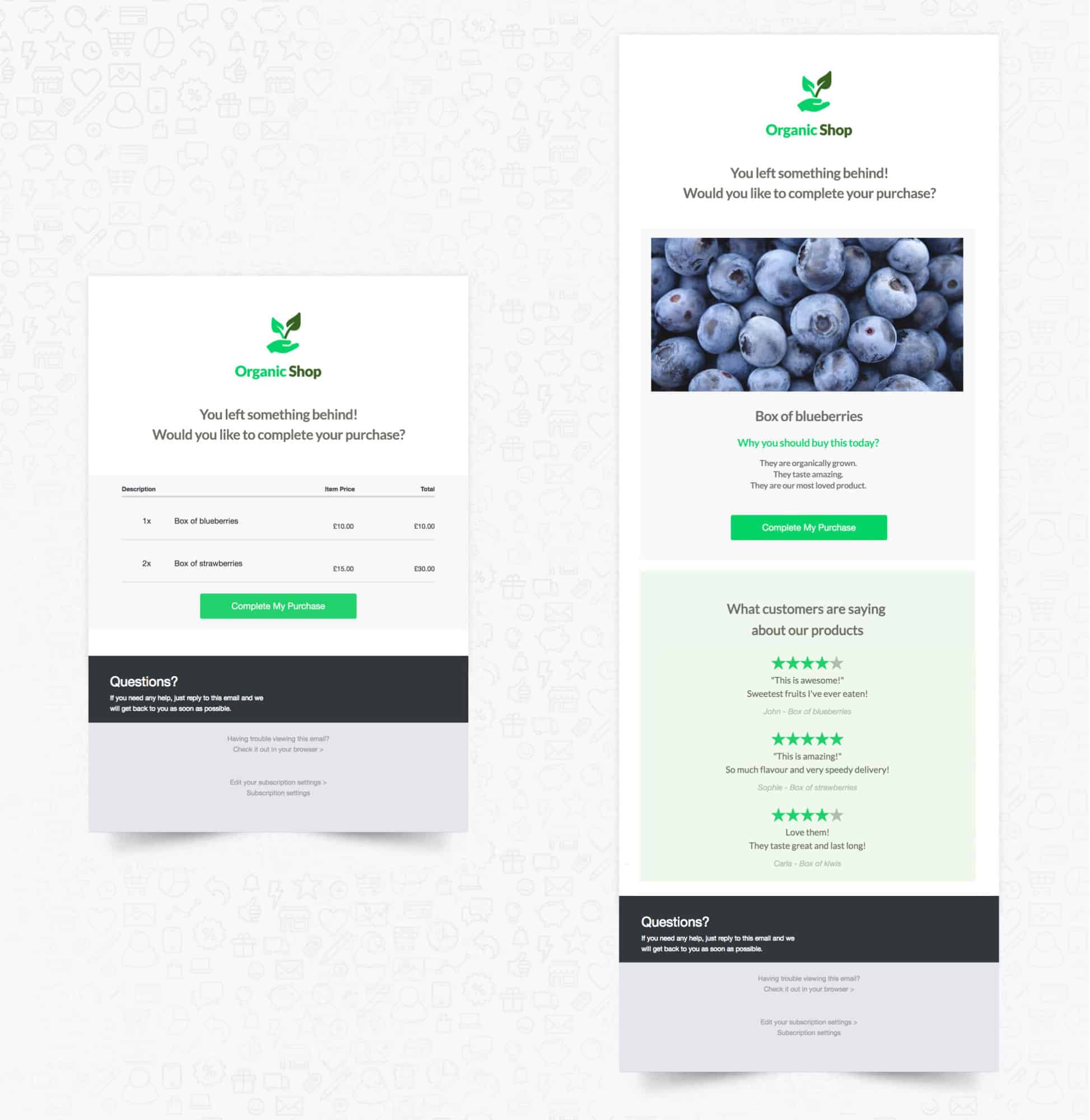
(Source: CM Commerce)
But just how effective is social proof at recovering sales? By optimizing their recovery emails and incorporating testimonials and other social proof elements, the fashion company, Roasted Fox, benefitted from a massive 33% increase in abandoned cart recoveries.
Incentivize with Loyalty Programs & Rewards
The next step in reducing cart abandonment rates is to create a customer incentive campaign.
Loyalty and rewards programs work well at reducing abandonment issues, as they give customers an additional reason to shop with you: Discounts or free merchandise.
In a recent case study, Smile.io found that customers who belong to a rewards or loyalty program spend 55% more money on average than non-members. In a study conducted by Virtual Incentives, 56% of consumers admitted personalized incentives positively impact their purchasing decisions. Moreover, only 40% of customers surveyed have actually received personalized incentives, meaning there’s a huge demand for personalized incentivization in marketing.
With the help of platforms like Smile.io, you can easily add your loyalty and rewards program into your abandonment recovery campaign.
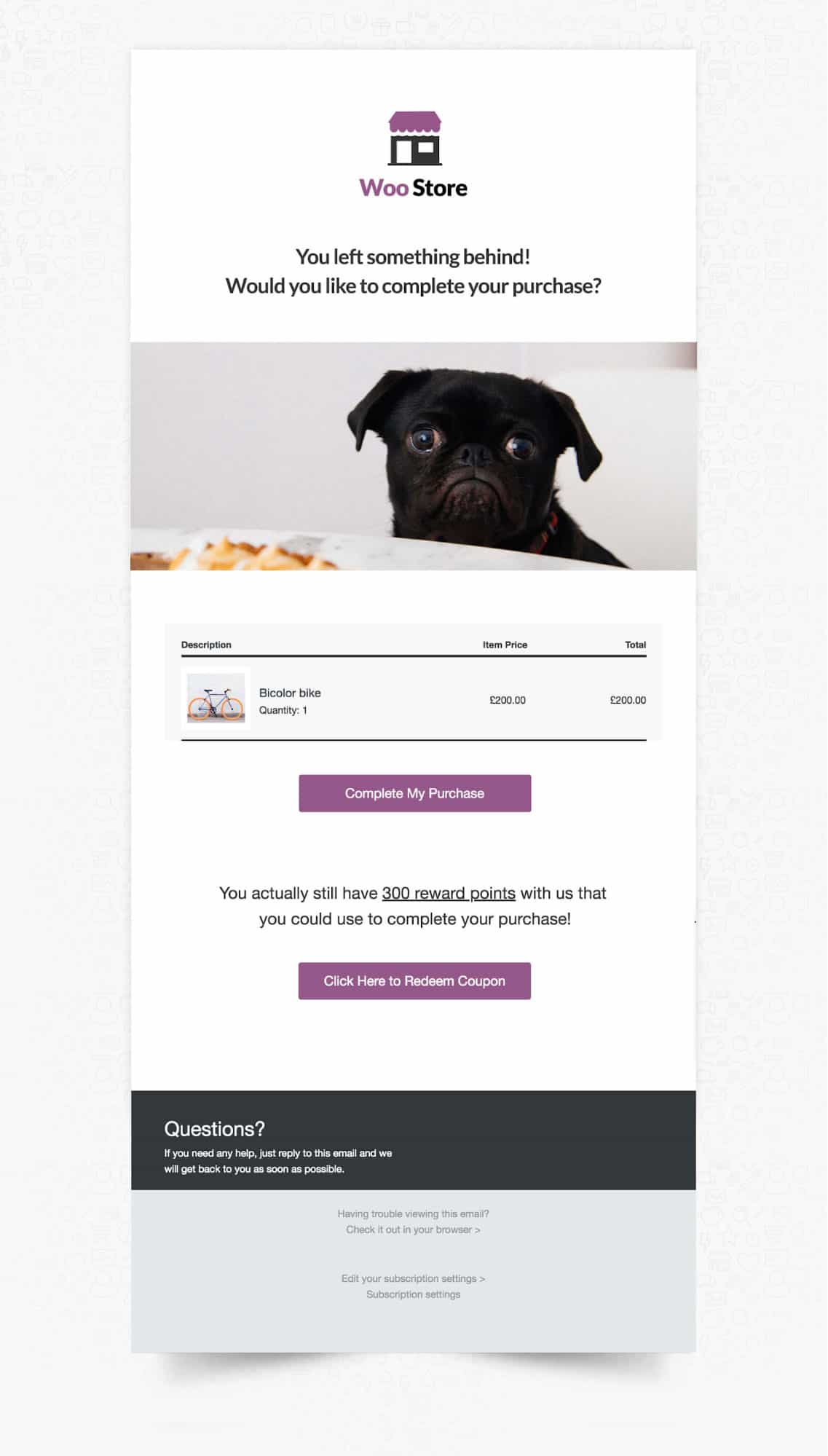
(Source: WooCommerce)
So what might that look like in action? Here’s one idea:
Segment Your Cart Abandonment Emails
Consider creating emails for your most loyal customers that include a tailored remarketing sequence—points systems or spending thresholds work well for monitoring and automating this.
Then, within the remarketing emails, highlight the customer’s points balance or proximity to a reward tier and remind him/her that the points earned buying an abandoned cart item will be applied toward that reward. Some experiments have shown that this approach can 6-12x recovered revenue per email.
What we can take away from this is: More than just a recovery strategy, a well-executed incentivization campaign is instrumental in establishing a long-lasting relationship with your customers.
Use Remarketing to Bring Back Shoppers
Remarketing is an excellent, cost-effective way to increase brand awareness and remind potential customers about your products. Basically, when a customer visits your ecommerce site and fails to make a purchase, they’ll see your advertisements when they visit websites that show advertisements from the Google Display Network.
Ideal for reaching out to customers who were seriously considering making a purchase, remarketing works to keep your products at the forefront of your customers’ minds as they browse other sites. You can even leverage the power of remarketing on popular social media platforms like Facebook, which is especially useful for targeting a mobile audience. And digital marketing tools like Shoelace make it quick and easy to automate a retargeting campaign over Facebook and Instagram.
Similar to email marketing, Facebook Messenger is also an effective platform for connecting with customers. And thanks to the help of the marketing platform, Recart, you can use Messenger as part of your abandonment recovery campaign.
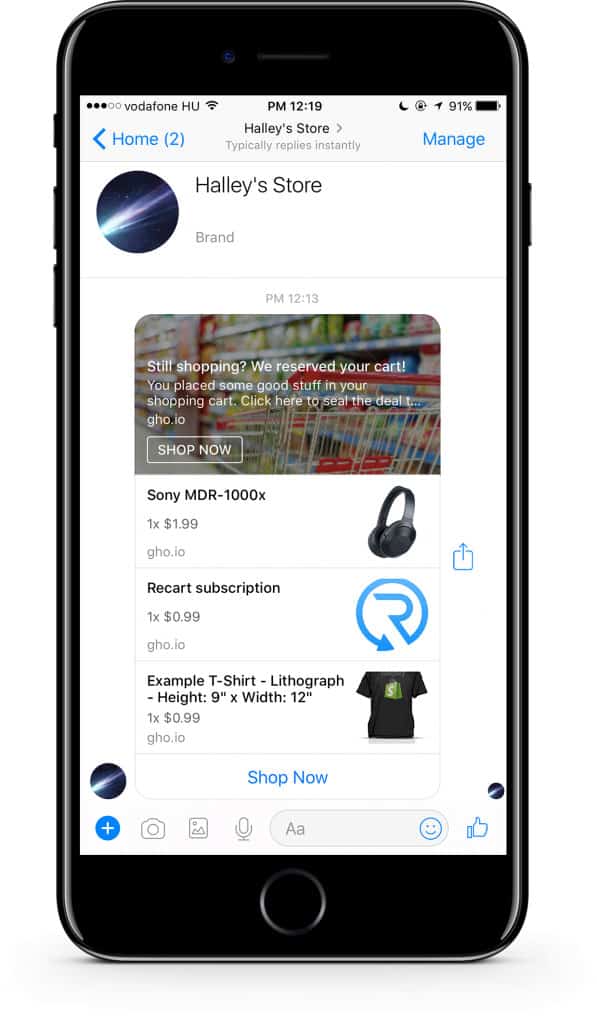
(Source: Recart)
Recart sends automated messages to potential customers, reminding them of the items left in their shopping cart while placing them one click away from finalizing their purchase.
Combining social media with a strategic email remarketing campaign keeps an open channel of communication between the customer and you. This is especially helpful when engaging with prospective buyers who abandoned orders (for reasons unrelated to your product), remarketing efforts can help you recover as much as 11% of your abandoned carts in a month.
Reduce Friction at Checkout
As mentioned earlier, accessibility and convenience play integral roles in determining whether the average customer will finalize their purchase or abandon their cart. Websites that are clunky or have unnecessarily complicated checkout procedures are far more likely to have a higher cart abandonment rate than sleek, optimized virtual marketplaces.
Removing unnecessary friction throughout your buying journey can help increase conversion rates. And a good place to start is with your forms. Research conducted by the Baymard Institute found that 61% of the top ecommerce sites in the US require customers to disclose “seemingly unnecessary” information during the checkout procedure.
Fortunately, optimizing the checkout procedure is a quick and straightforward process. Simply remove all unnecessary forms, only requiring customers to put in the necessary information. You might also want to consider adding a guest checkout option for customers who don’t want to take the time to create an account just to purchase one or two items.
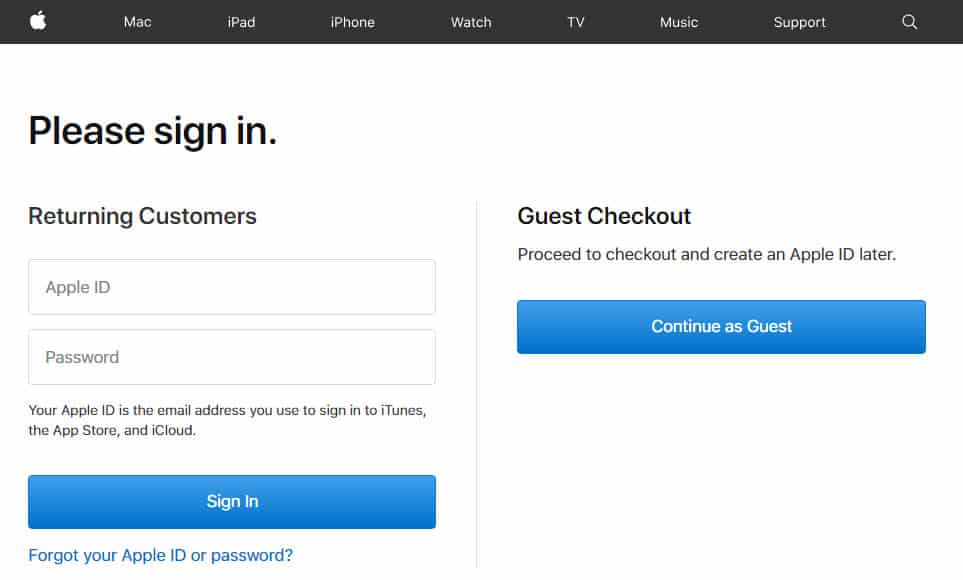
Guest checkout is great for customers who want to make a quick, one-time purchase. (Source: Apple)
The last element that could be causing unnecessary friction is poor customer support. Whether the buyer has a question about your product description or they’re experiencing an issue with your payment gateway, they expect assistance as soon as possible.
Adding a live chat feature is one way to ensure that your customers’ needs are being met accordingly. Research conducted by Forrester found that 44% of online shoppers believe the ability to chat with a support agent in the middle of their online purchase was one of the most important services a website should offer.
Build Trust During Checkout
When you stop and think about it, there’s a lot of trust that goes into online shopping. The customer provides you with their credit card details and contact information, then trusts you won’t use this information for anything other than its intended use.
With that in mind, it’s easy to understand how some shoppers are reluctant to shop online—especially with smaller companies that don’t have the same reputation as Amazon and other big-box retailers. For this reason, it’s important that you assure customers that their personal data is safe with you.
And one way that you can reassure customers that their information is protected is by adding a trust logo to your site.

Different types of trust logos (Source: Actual Insights)
Research conducted by Actual Insights found that 61% of online shoppers abandoned their purchase because trust logos were missing. Moreover, the study also found that 75% of customers didn’t make a purchase because they didn’t recognize the trust logo on the site.
Which trust logos are universally respected? A study conducted by the CXL Institute found PayPal and Google logos received the most attention in an eye-tracking test, but that a number of well-known brands lead the list for most-trusted security logos, including Norton, McAfee, and the Better Business Bureau.
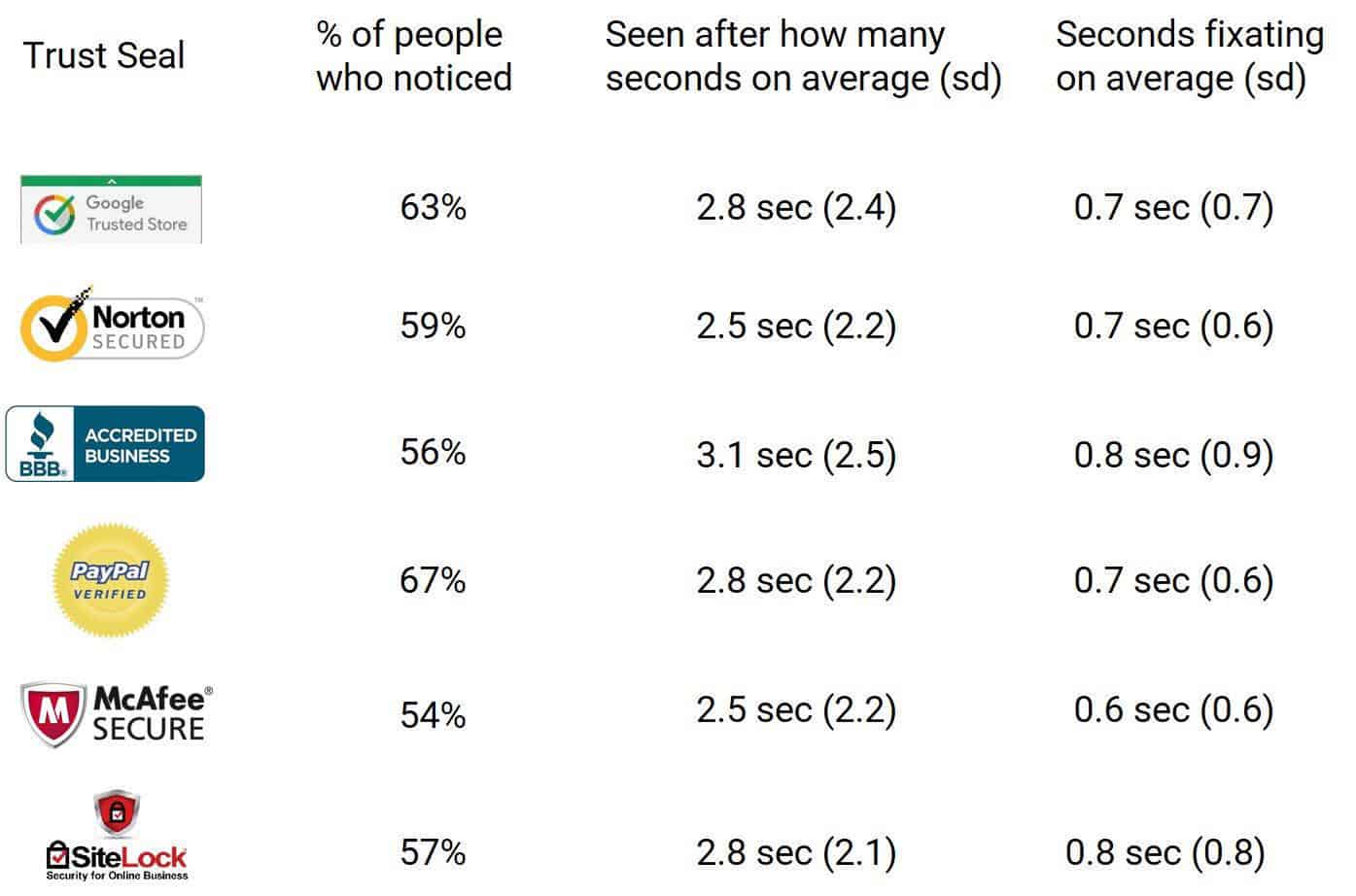
(Source: Conversion XL)
And the verdict? Google Trusted Store, PayPal, and Norton are likely your best choices for increasing customer confidence. Of course, you’ll also want to offer an SSL Secure Connection so that your customer’s information is encrypted and protected against any third-party snooping.
Leverage Elements of Scarcity
Have you ever known somebody who always wanted what they couldn’t have? If so, you’re already acquainted with the concept of scarcity.
In the realm of marketing, scarcity is an effective way to create demand around a product or service. By giving the customer a limited amount of time to take advantage of an offer, you create a sense of urgency that motivates them to take immediate action.
But what is it about scarcity that pushes seemingly uninspired consumers to spend money on a product? To understand that, we need to look at the psychology behind it.
- Scarcity Creates a Feeling of Exclusivity: I have something that nobody else does, therefore I’m special.
- People Often Assume Scarce Products are More Popular: If the product is selling out then it must be good, after all.
- We Assign More Value to Scarce Items: Case in point: Diamonds. Although not as scarce as we’re led to believe, diamonds are valuable today because of a brilliant marketing strategy by De Beers to limit the supply and demand of diamonds worldwide, increasing their scarcity.
According to the Loss Aversion Theory by psychologist Daniel Kahneman, the feeling of loss is twice as powerful as the pleasure of gaining something. In other words, this theory suggests that people will put more effort into not losing than they do in winning. And from an ecommerce point of view, it makes perfect sense when you consider how effective countdown timers are at driving sales.
Other ways you can use scarcity to boost your conversion rates include:
- Limit the quantity of a product being sold
- Sell an item for a limited amount of time
- Offer special deals like free shipping or 15% off for customers who buy within a specific timeframe
Scarcity works because it taps into our fear of missing out on something, otherwise known as FOMO. And when utilized correctly, scarcity can become one of the most effective strategies in your marketing playbook.
Start Reducing Ecommerce Cart Abandonment Today
To recap, cart abandonment accounts for approximately $4 trillion worth of lost sales worldwide.
While there are various reasons why customers choose to abandon their online purchase, a significant portion of them can be prevented by optimizing your website, making the sales process quicker, secure, and more efficient.
Instead of looking at cart abandonment as something that’s bad for your business, see it as an opportunity to connect with your customers. Remarketing emails, social media engagement, and personalized loyalty programs go a long way in helping you recover abandoned carts, while also increasing brand loyalty among your customers.



